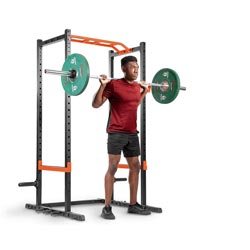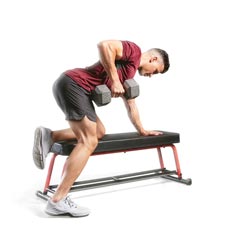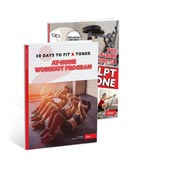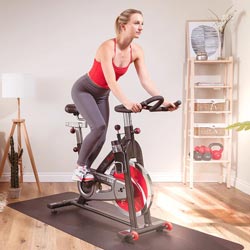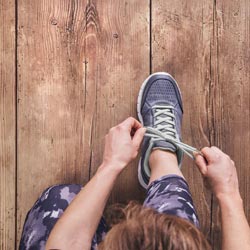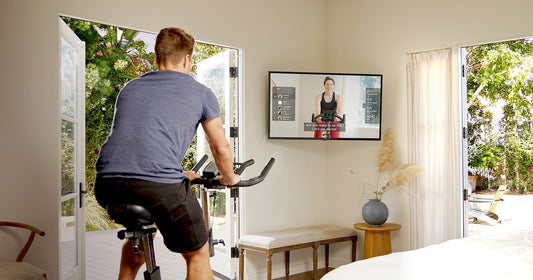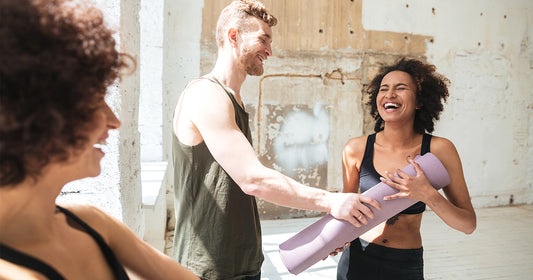Regular exercise is proven to boost your immunity against infections. However, if you don't clean and disinfect your workout equipment, you're not safe from getting sick. With the presence of the COVID-19 virus and other germs, keeping your home and surroundings clean is more important than ever.
Here's a guide on how you can properly clean and disinfect your exercise equipment at home.
Why Sanitize Your At-Home Workout Gear?
Even if you're the only one (or a few others in your household) who uses your home gym, you still want to give it a good clean each time.
Why?
One word - bacteria.
Mounting research suggests that gym equipment harbors many types of bacteria, including E.coli and Staphylococcus aureus, which is known for causing staph infections.
Another study shows that a cycling bike has 79 times more bacteria than a water faucet. Meanwhile, free weights are 362 times filthier than a public toilet. What's more, over 70 percent of bacteria found in exercise equipment are potentially harmful to humans.
Despite your best intentions to become healthier, filthy workout equipment in a confined space makes a perfect breeding ground for fungi, viruses, and bacteria to lurk. Some of the most common diseases you could pick up even in your very own home gym are skin rash, athlete's foot, ringworm, and cold and flu.
How to Sanitize Your Home Gym Equipment
Keeping your workout gear clean and sanitized is easier than you think.
Firstly, you need to have the right tools and supplies. You'll need:
- Disinfecting wipes – some gym equipment shouldn't be cleaned with soap and water as they have electronics and parts that can get damaged or corroded. Using disinfecting wipes is your safest option for cleaning and sanitizing your gear.
- Disinfectant spray - disinfectant sprays are very convenient to use, aside from being effective at eliminating germs and bacteria. Since most of them are alcohol-based, they evaporate quickly and are therefore ideal for equipment.
- Microfiber cloth - after spraying your workout gear, you can wipe down the entire surface with a microfiber cloth. Alternatively, you can use paper towels.
Exercise Bikes, Treadmills, Ellipticals, and Rowing Machines
Today's exercise machines are packed with high-tech features, such as Wi-Fi capabilities, LCD touchscreens, TVs, and more. Since they have electrical components, you want to be extra careful when cleaning your machines.
Follow these steps to safely and effectively stave off bacteria from exercise bikes, treadmills, ellipticals, and similar equipment.
- Use sanitizing wipes or microfiber fiber dampened with a disinfectant spray or sanitizing solution to gently remove dirt, dust, stains, fingerprints, etc.
- Avoid spraying directly on the surface as it can cause damage, especially to cardio equipment.
- Wipe grips, handles, screens, nooks, and crevices of the equipment. Wipe down the entire machine, including the seats.
- Use a dry microfiber to facilitate drying.
Strength Racks and Weight Benches
To sanitize strength racks and weight benches, simply wipe them down with a cleaner. Let them air-dry since the cleanser needs time to kill the bacteria.
Wipe down the entire surface with a dry cloth before use. These equipment can be a little slippery when wet.
Resistance Bands and Suspension Trainers
Cleaning your resistance bands and suspension trainers with sanitizing wipes is convenient for daily use. However, it isn't enough to get them thoroughly cleaned. Once in a while, or at least every week (if you exercise daily), you want to give them a deep clean.
Resistance bands and suspension trainers can be pretty challenging to clean because they are floppy and stretchy. Therefore, the best thing you can do is to dip them in warm water with a bit of dish soap or mild laundry detergent.
Gently scrub the surfaces to remove dirt and grime. Let your bands dry afterward but not under direct sunlight to preserve the material quality.
Yoga Mats and Floor Mats
There's nothing worse than rolling out a filthy exercise mat that hasn't been cleaned since time immemorial.
Yoga mats and floor mats are among the dirtiest workout gear because they absorb all the oil, sweat, and grime. Not only do they get dirty and smelly, but these mats can also become contaminated with germs quickly.
Here are some easy ways to disinfect your yoga or exercise mats:
- After each use, spritz the mat with tea tree oil or vinegar-water solution (mix equal parts of water and white vinegar.) Let the disinfectant sit for about a minute to eliminate all the germs.
- Then wipe down the entire surface.
- Hang your mats to let them air dry before rolling them up to store.
- If your mat is really dirty, or at least once a month, you can clean it with soapy water. Just soak the mat in warm water with some mild dish soap. Gently scrub the surface to remove tough dirt and stains. Don't scrub the mat too much, since you want to keep the sticky nature of your mat. Rinse it well and shake off excess water. Hang your mat and let it air-dry completely.
Gym Floor
You want your entire home gym cleaned, not just your equipment. Since it's prone to dirt, sweat, and grime, regularly clean your gym floor and disinfect it.
Rubber Floor
Rubber flooring is low-maintenance. It resists mold, mildew, and stains. That said, cleaning a rubber floor is pretty simple. Use a non-acidic cleanser, a mild dish soap, and a rubber floor finish to clean it.
To sanitize a rubber floor, use a pH-neutral cleaner mixed with warm water. Before you deep clean the entire floor, take care of any obvious spot that needs extra TLC.
Tile Floors
For tile floors, you can clean them using soap and water. You can add some bleach or vinegar to disinfect your tile floor.
To keep your floor free from disease-causing germs and bacteria, consider these cleaning tips:
- Clean often. Mop the floor regularly. This way, you won't have to deal with tough grime and dirt.
- Tackle loose debris first. Use a vacuum or a broom to remove dirt, crumbs, and other debris.
- Mop the floor from back to front.
- Don't use too much detergent.
- Dry the floor. Never exercise on a wet or slippery floor.
Wood Floors
Wood floors are tricky to clean. There's a lot of debate on whether you can disinfect wood floors without damaging them. To be safe, it's better to skip the DIY cleaners and go with a disinfectant cleaner that's specifically formulated for hardwood floors.
How Often Should You Clean Your Home Workout Equipment?
Cleaning your exercise machines doesn't only keep them in top condition, but it also keeps the nasty germs away.
Your daily cleaning routine should include wiping down surfaces with a cloth dampened with disinfectant. Don't forget to dry the surfaces completely with a clean, dry cloth.
Each week, you can dedicate more time removing visible dirt and polishing your machines. Avoid using chemicals that can damage your equipment.
Conclusion
Sanitizing your exercise equipment helps prevent the spread of germs and bacteria that can make you and your family sick.
Dust, sweat, and dirt can stick to surfaces and harbor filthy microorganisms. Frequently touching workout equipment, such as the handles and grips, allows germs to spread in your home quickly.
Thankfully, sanitizing your workout equipment is easier than you think. You only need a few tools and supplies, which you probably already have.
Spending a few minutes wiping down machines or equipment after use may sound like an added work, but it's the best way to protect yourself from possible infections. Plus, regular cleaning will lengthen the lifespan of your equipment.
Written By:
Mariam Novak is a Hygiene Specialist working with SONO Healthcare. Mariam believes that house cleaning is a critical part of hygiene. She delivers new cleaning expert advice on sanitizing products, tools, and different items, which sometimes include medical instruments and home equipment.


